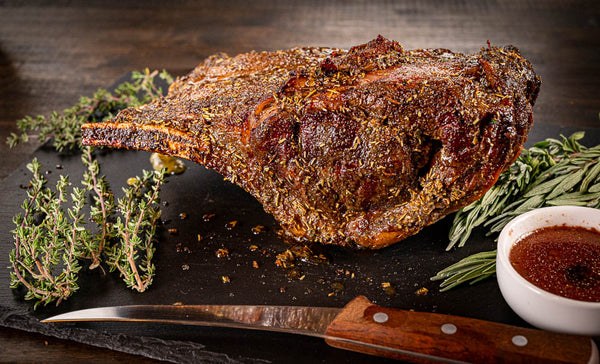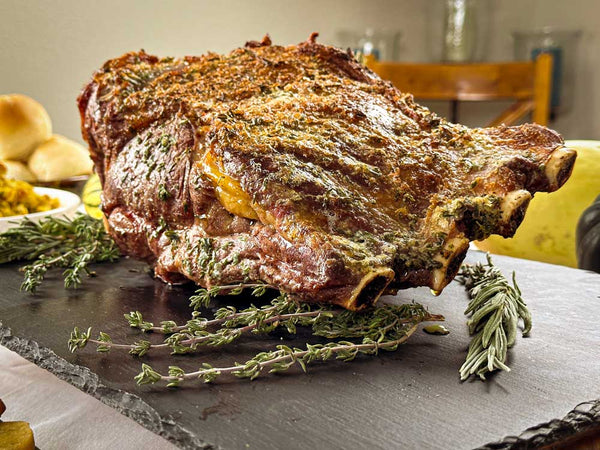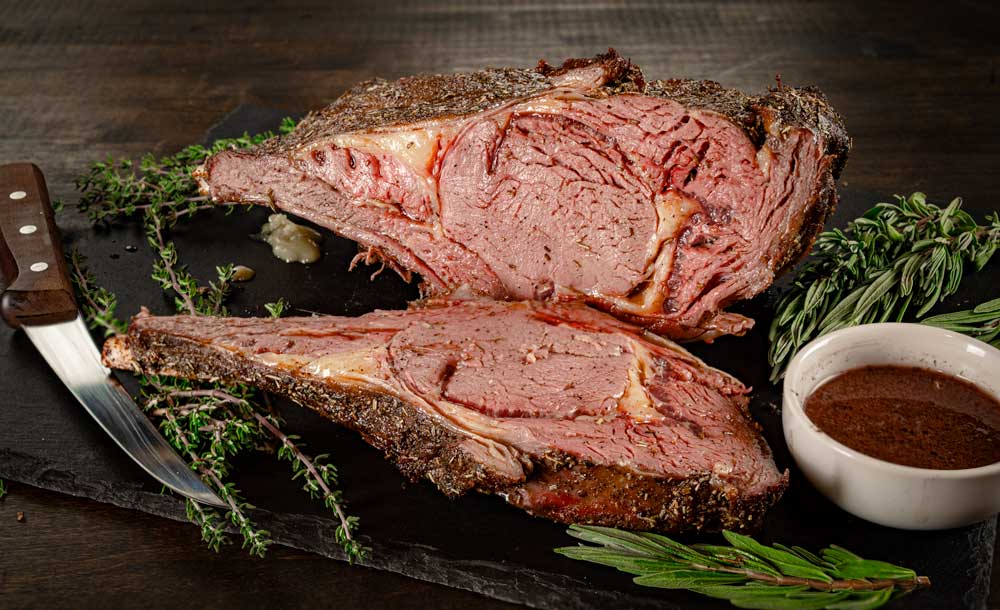Cooking a bison prime rib can be a bit intimidating for those unfamiliar with the cut, but with a few simple steps, you can create a delicious and impressive meal for your family and friends.
If you’ve ever bought a bison steak from us, you have heard us recommend using the reverse sear method for cooking your steak. The same is true with a prime rib, with a few minor adjustments to the process. The result will be picture-worthy edge-to-edge rosy perfection with a golden brown crust.
You may have also heard us talk about using a sous vide. Using a sous vide is the best method for cooking any steak, and the same is true for a prime rib. But this is an excellent alternative if you have yet to make that investment.
THE SLOW ROAST
Low and slow is a phrase that is frequently used as a rule of thumb when cooking any bison meat. While the prime rib is the most marbled cut from a bison, it can still be leaner than the equivalent cut from beef. Overcooking lean meat is the quickest way to end up with a dry and tough piece of meat.THE BIG CHILL
Plunging a cooked piece of meat in an ice bath may seem counterintuitive. But this is an important step to cool down the exterior of the roast. A large stock or even the kitchen sink can be used for this step. Just fill with cold water and plenty of ice.
If skipped, the butter will melt quickly, making it difficult to get a good coat spread all over the roast.

THE COAT
Coating the roast in the butter compound enhances the Maillard reaction in the oven, which creates that golden brown sear. Room-temperature butter will be easiest to spread with a butter knife, a fork, or a spatula.
Combining the butter with herbs and spices will enhance the crust’s flavor. Thyme and rosemary are popular favorites but feel free to explore other options. However, there is no need to overdo it. Bison meat is richer and sweeter and does not depend on a lot of seasonings to make it palatable.
THE SEAR
The sear is the big finish and a very crucial step. While the roast is fully cooked at this point, it will look and taste very bland. The high heat results in the Maillard reaction, which adds texture and flavor. For the foodies out there, this article on Serious Eats is a good resource for understanding what is happening. Mailard Reaction

Ingredients
Bison Prime Rib RoastLight olive oil
1 cup softened butter
2 tablespoons thyme
2 tablespoon rosemary
1 tablespoon sea salt or kosher salt
1 tablespoon black pepper
Here’s how you can cook your bison prime rib to perfection:
- Thaw your prime rib in the refrigerator. Leave in the vacuum packaging and let it rest for a few days, up to two weeks. Doing so will also wet age the meat and improve the already great flavor.
- Remove from the package and pat dry with paper towels. Coat with a light olive oil or similar.
- Insert a meat thermometer and place your roast on a baking sheet in a 220° F oven.
- Allow to slow roast up to your desired temperature. We recommend about 132° F. This will take a few hours.
- Remove the roast from the oven and turn the oven up to 500° F or set to broil.
- Place the roast in a large plastic bag and chill in an ice bath for 10 minutes. This will stop cooking and prevent overcooking in the final searing step.
- Combine softened butter, salt, pepper, and herbs.
- Remove the roast from the ice and bath and pat dry with paper towels.
- Spread the butter and herb combination over the entire roast.
- Return the roast to the oven on the baking sheet and sear for 15 minutes or until golden brown.
- Remove your roast from the oven and carve into serving-sized slices.
- Enjoy!

Following these simple steps, you can perfectly cook your bison prime rib. The result is a savory, tender, and flavorful roast that will impress your guests and make them feel like they’re dining in a high-end steakhouse. This epic roast will become the centerpiece of memorable dinners for years to come.


